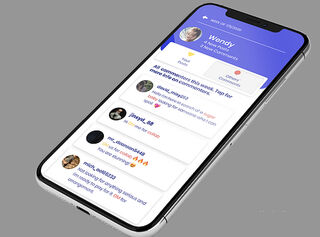Media
The Darkest Side of Social Media
A new tool signals the stealth recruitment of teens for sex-trafficking.
Posted July 30, 2021 Reviewed by Hara Estroff Marano
Key points
- July 30th is World Day Against Trafficking in Persons, and there's good news in combatting this scourge.
- In the US, traffickers do most of their recruiting online, but a new technological fix is available to thwart them.
- A phone app can warn parents or guardians if their child's online hashtags and images make them vulnerable to sex traffickers.
Sex-trafficking is a $150 billion a year industry, a modern form of slavery that operates in plain sight, affecting 40 million people today. July 30th is World Day Against Trafficking in Persons. Grim as the subject of human trafficking is, this year there’s some good news to report: A powerful new tool, Radlee, can help thwart traffickers’ efforts at online recruiting. That’s important because most sex-trafficked women in the U.S. are scouted on Instagram and other social media platforms.
To understand the value of the new antitrafficking tool, consider a common social media experience. A person starts receiving ads that are uncannily related to something he or she just posted. A dad posts an image of the family dog. Soon he starts seeing ads for dog food.
Normally the ability of advertisers to target where they spend their advertising dollars is benign. However, in the human trafficking world, the ability is sinister.
Just as a picture of a dog can activate the dog-food companies, certain images and hashtags will alert sex traffickers that a teen is vulnerable to being recruited into trafficking. Roger Martin, recently retired from the high-tech company Qualcomm, has been studying the scope of the problem. He’s also working on ways to do something about it.
Mass Online Grooming
The scope of the problem is breathtaking: The overwhelming majority of sex trafficked women in the United States are recruited on social media.
Martin was shocked to learn that in San Diego, where he lives, 80% of trafficked women are U.S. citizens, most of whom were recruited online. As he looked deeper into the issue, he realized that social media is a made-to-order system for a trafficker to multiply the number of possible victims.
“In the past,” says Martin, “a trafficker might go to the mall to recruit a teenage girl. It was a one-on-one business. Today, a trafficker can scroll through Instagram, and, in a day, he might find 100 potential victims.”
Martin reasoned that if dog-food manufacturers could figure out the kind of information needed for placing dog-food ads, maybe he could discover the kinds of information sex traffickers are looking for when targeting a potential victim.
The hope was that if he could figure out what catches the attention of a trafficker, he could warn potential victims. Artificial intelligence excels at detecting patterns, and he knew how to use it. In the space of a year, he had millions of accounts of potential victims to analyze.
The results were revealing. “The computer began to spit out indicators of which kids traffickers would target,” says a pleased Martin.
Images and Hashtags that Scream Vulnerability
Martin learned that specific kinds of images and hashtags help traffickers to decide which young people to target. Examples include:
- A young girl poses provocatively in a scanty bikini. “That would let the trafficker know that the girl probably didn’t have adult supervision monitoring her social media,” points out Martin.
- She uses hashtags such as, #teenmodel or #scout me. “This lets the trafficker know she’d be vulnerable to promises of a modeling contract,” explains Martin.
- She uses the hashtag #sexy. “This is a very strong signal to traffickers that a girl is desperate for attention,” says Martin.
A Trafficker’s Playbook
According to Martin, once a trafficker has found a likely target, he’ll probably follow one of several tried-and-true playbooks. A common one is, he tells her he’s from a modeling agency and would like to take some sample pictures.
She goes to his studio, he takes some head shots, maybe he pays her, and she goes home feeling on top of the world. What she doesn’t know is, this was a ruse to establish trust. It was all about getting her to let her guard down.
She returns, and this time he asks her for a more provocative pose. It isn’t too big an ask, and she agrees to it. He’s gradually getting her used to blurring the lines of what she would normally refuse.
Next, he asks to photograph her topless. She’s still convinced that she’s on her way to a great modeling career and complies.
Now he wants naked pictures. He leads her to believe that if she’ll just take this one additional step, she’ll have the paradise career she yearns for.
Now he has a collection of totally compromising image. He tells her if she doesn’t allow sexually explicit pictures with men, he’ll show the pictures he already has to her parents, her school, and all her social media.
Terrified, she complies. And so another girl is on her way to entering “the life.”
Thwarting the Process
Martin is working to thwart the process. He’s using the high-tech tools to find and warn girls and their parents in those cases where the girl’s social media is the equivalent of a red flag in front of a bull.

The goal is to make vulnerable girls aware by sending them targeted messages that warn them not to fall for fake modeling jobs.
A preventive approach available to parents and guardians right now is the iPhone app Radlee, available at the App Store. A parent can put in the girl’s name and Instagram information and the app will check whether the child has a profile that would attract a trafficker.
Further, Radlee can even tell if the young woman is already being contacted by someone who fits the profile of a trafficker. Armed with this information, the adult in the girl’s life can take steps to protect her.
With the help of the financial institution UBS, and Humans Against Trafficking, Martin is also enlisting social media influencers to warn young people about the online scams that traffickers deploy.

While high tech may be brilliant at selling dog food, it’s also making inroads combating online human trafficking. That’s really something to celebrate this World Day Against Trafficking in Persons.




